It wasn’t very close.
Toronto’s offense blew the doors off of the defensively-lacklustre Vancouver Canucks in this game, winning by a final score of 7-3. More importantly, the Leafs dominated the puck from start to finish, significantly outshooting and out-chancing the Canucks at even strength.
The game clearly started to get out of hand towards the end, but that still leaves plenty of hockey to analyze. Let’s see what we can take out of this game by breaking down each player individually.
5/5 Stars
Game Puck: Jason Spezza (RW, #19) — From the press box in Game 1 last season to the waiver wire in 2021, it’s definitely been a weird homecoming for Spezza. After an underwhelming start to the season, a lot of us weren’t sure what to make of him.
Then he goes out and scores a hat-trick.
This was goal number three for Spezza and the smile says it all. What a wild ride it’s been for him towards the end of his career here.
He’s obviously not going to score three goals every night, but we’re starting to see more of the offensive value that made Spezza one of the most productive bottom-six players in the NHL last season. When you throw in his ability to play the right wall on one of Toronto’s power-play units, not to mention his faceoff specialist role on the PK, I’d say you have quite the bargain at $700,000.
Auston Matthews (C, #34) — His hands were on full display tonight. At 6’3, I’m not sure how many players in NHL history can stick handle as well him, but we’re talking about a very short list; the Mario Lemieux’s and Jaromir Jagrs of generations past. Matthews used that combination of length and puck-handling ability to get himself to good spots on the ice, where he generated a team-high six shots from the slot.
His best play was on this one-on-one rush against JT Miller.
Poor JT Miller.
Mitch Marner (RW, #16) — After a quiet first period, Marner opened up the second period with a few A+ passes to break down the defense. They didn’t result in a goal, but when you make a cross-seam pass to Tavares for a one-timer off of the cross bar, you’re doing your job.
On his next shift, he did this.
This is the hard part about evaluating Marner’s play on a nightly basis. There are games when he isn’t able to pull off these game-breaking passes, but when he does, the puck is in the back of the net. Sometimes I think we tend to forget just how valuable that is.
He was also able to beat Thatcher Demko with a wrist shot late in the game, scoring Toronto’s seventh goal of the night. Needless to say, it was a rough night for Demko.
William Nylander (LW, #88) — In under 14 minutes, Nylander was able to rack up three assists. That’s what us nerds like to call efficient. My favourite pass he made was this backdoor feed to Tavares off the rush.
There’s not a stat for this, but I’d love to know who the NHL leaders are in “open nets created for teammates” – I have a feeling Nylander would rank first on Toronto this season.
Morgan Rielly (LD, #44) — If we’re going to criticize Rielly when he has a rough night, we need to praise him for games like these. Toronto dominated play when he was on the ice, thanks in large part to his breakout passing.
He’s one of the most “active” defensemen in the league, always looking to jump up in the play and give his team numbers off the rush. If you watch that Nylander clip again, you’ll see that Rielly didn’t even have numbers the rush where he picked up an assist; it was a 4-on-4 rush when Rielly cut back to the middle before finding Nylander on the far side of the ice.
4/5 Stars
Nic Petan (LW, #61) — When was the last time you remembered Toronto’s fourth line looking this dangerous off the rush?
That’s one heck of a saucer pass by Petan to get Spezza in open ice for the goal. Petan’s ability to carry the puck up the ice, make a defender miss, and complete the next pass to a teammate is a big part of the reason his line had the puck so often.
There were a few moments defensively I didn’t love, namely a neutral zone pinch when he was covering for a defenseman, leading to a 2-on-1 for Vancouver. All things considered, though, it was a breath of fresh air to see someone with skill make plays on Toronto’s fourth line. He’s certainly earned himself a longer look.
TJ Brodie (RD, #78) — He had a few great breakout passes to start the rush offensively for Toronto. Sometimes it was a slip pass underneath. On others, he’d look for the long stretch pass. Brodie also looked solid defensively, taking away passing lanes through the middle of the ice.
He’s made a few of these plays now this season. I think it’s fair to say he’s pretty good at timing that 2-on-1 slide, which is an important attribute if you want to prevent goals as an NHL defenseman.
Zach Hyman (LW, #11) — I was listening to one of Justin Bourne’s radio hits the other day and he was joking how Kyle Dubas, Sheldon Keefe & company could go 2-plus months without mentioning Hyman’s name back in his Marlies days. Sometimes that level of consistency in a player’s performance makes them difficult to analyze night after night – you know exactly what you’re going to get.
Hyman was doing his usual Hyman things: winning puck battles in the offensive zone to help his team secure puck possession for the majority of their shifts. He also delivered a textbook screen on Spezza’s power-play goal, which I’m sure will make Manny Malhotra proud.
John Tavares (C, #91) — It’s hard to evaluate Tavares’ performance when his teammates all go off for multi-point nights and he “only” has the one goal to show for it. Tavares did a great job of winning pucks back out of tough areas, which helps explain why his line had the puck so much at even strength. He also broke Quinn Hughes’ ankles off the rush, drawing a penalty in the process.
3/5 Stars
Wayne Simmonds (RW, #24) — As much as I love Simmonds’ energy, it was pretty noticeable to me how much he struggled to keep up with Tavares’ and Nylander’s click-click passing in transition. That said, Simmonds did win a battle along the wall that helped start a rush leading to the 5-2 Tavares goal, where he went to the net and occupied Tyler Myers’ stick/attention as the pass threaded through to the backdoor.
With 3:01 left in a 7-3 hockey game, Simmonds hit Hughes hard into the boards and then accepted a fight with Jordie Benn.
Talking about this kind of stuff isn’t exactly my forte – I tend to be the one asking if he really needed to throw that hit – but every former player seems to love playing with these kinds of guys. Maybe it’s one of those things that’s tough to measure but has real value.
Alec loved it:
Simmonds trying to toey someone off the wall, firing a shot into the corner, burying a dude and then fighting on a late shift in a 7-3 win is a top-5 moment this season so far https://t.co/73Ug33Kmce
— Alec Brownscombe (@MapleLeafsHS) February 5, 2021
Zach Bogosian (RD, #22) — With Travis Dermott going down early, Toronto was forced to ice only five defensemen for the entire game. The fact that they were able to play so well despite the 5D issue speaks to Bogosian’s steadiness in this game.
It certainly helps when you get to play more minutes with Jake Muzzin. Then again, it was Bogosian who broke up an Elias Pettersson backdoor saucer pass on an odd-man rush. Toronto’s number-six defenseman stood his ground in this game. Good for Bogosian.
Jake Muzzin (LD, #8) — As we just mentioned, Muzzin spent a good portion of his minutes with Bogosian and still performed well in those minutes. If Nikita Zaitsev wasn’t proof enough, I’d say it’s pretty clear that Muzzin can succeed at even strength with anyone as his partner.
Justin Holl (RD, #3) — My favourite Justin Holl plays tend to be those little things in the neutral zone most fans aren’t looking for: killing a play early with a tight gap, or getting his stick on the puck when it looked like he didn’t have the angle. He’s become one of the team’s best transitional defenders.
As a side note, he played 6:19 with Rielly at even strength and the two dominated there, out-chancing Vancouver 5-0 and potting a goal for good measure. Those two also looked good in the playoffs when they got a few shifts together. Just something to keep in mind.
Travis Boyd (C, #72) — Spezza and Petan were driving most of the offense on Toronto’s fourth line, although Boyd was able to contribute by winning some puck battles along the wall.
Incomplete: Travis Dermott (LD, #23) — The poor guy only got to play 1:04 before leaving the game early with a charley horse.
2/5 Stars
Ilya Mikheyev (RW, #65) — He can’t keep shooting zero percent all season, right? With all the rush chances he’s generating, especially on the PK, you’d figure one of them has to cross the goal line eventually. At the same time, when Mikheyev shoots it into a goalie’s chest or puts it a few feet over the net on those two or three chances he gets per night, it doesn’t inspire much confidence.
Jimmy Vesey (LW, #26) — One of these nights, I’m hoping to have a long list of notes of plays where Jimmy Vesey noticeably impacted the game. Still waiting for that night.
Alex Kerfoot (C, #15) — He looks really out of place on the power play. Kerfoot didn’t provide any help on the PP entries and he’s certainly not a shot threat once the 5-on-4 unit sets up in the offensive zone. As a side-note, of course Kerfoot took a penalty while on the power play despite getting crushed face-first into the boards earlier in the game with no call.
Part of you wants to believe the refs must have it in for the guy. Then again, discipline was a major issue for Kerfoot last season, too.
1/5 Stars
Frederik Andersen (G, #31) — The team in front of him dominated this game for the most part. Andersen did not. The first goal was a weird bounce in front, but it’s goals two and three that you don’t love.
Miller was able to out-think Andersen twice from the top of the left circle. On Vancouver’s second goal, Miller got Andersen to bite on the fake shot before firing a cross-seam pass to Bo Horvat for the one-timer, who had a lot of net to shoot at. The next time Miller got the puck in that spot, he caught Andersen cheating off his post and was able to beat him with a short-side wrister.
Heat Map
Here’s a quick look at where each team’s shots were coming from at even strength, courtesy of Natural Stat Trick.
The Leafs controlled 66 percent of the shots and 68 percent of the scoring chances. Like we said at the beginning, it wasn’t close.
Game Score
Game score is a metric developed by The Athletic’s Dom Luszczyszyn to measure single game performance. You can read more about it here.
That’s a lot of blue; easily the most we’ve seen this season.


![Sheldon Keefe on the Maple Leafs’ struggling power play: “[We’ve scored] one out of 11 high-danger chances in tight to the net… We have been in those spots and haven’t converted” Sheldon Keefe, playoff press conference](https://mapleleafshotstove.com/wp-content/uploads/2024/04/keefe-pc-game-3-218x150.jpg)

![Jim Montgomery Post Game, Bruins 4 vs. Leafs 2: “[Marchand] still manages to get under people’s skin, yet he doesn’t cross the line” Jim Montgomery, Boston Bruins post game](https://mapleleafshotstove.com/wp-content/uploads/2024/04/jim-monty-pg-to-218x150.jpg)




















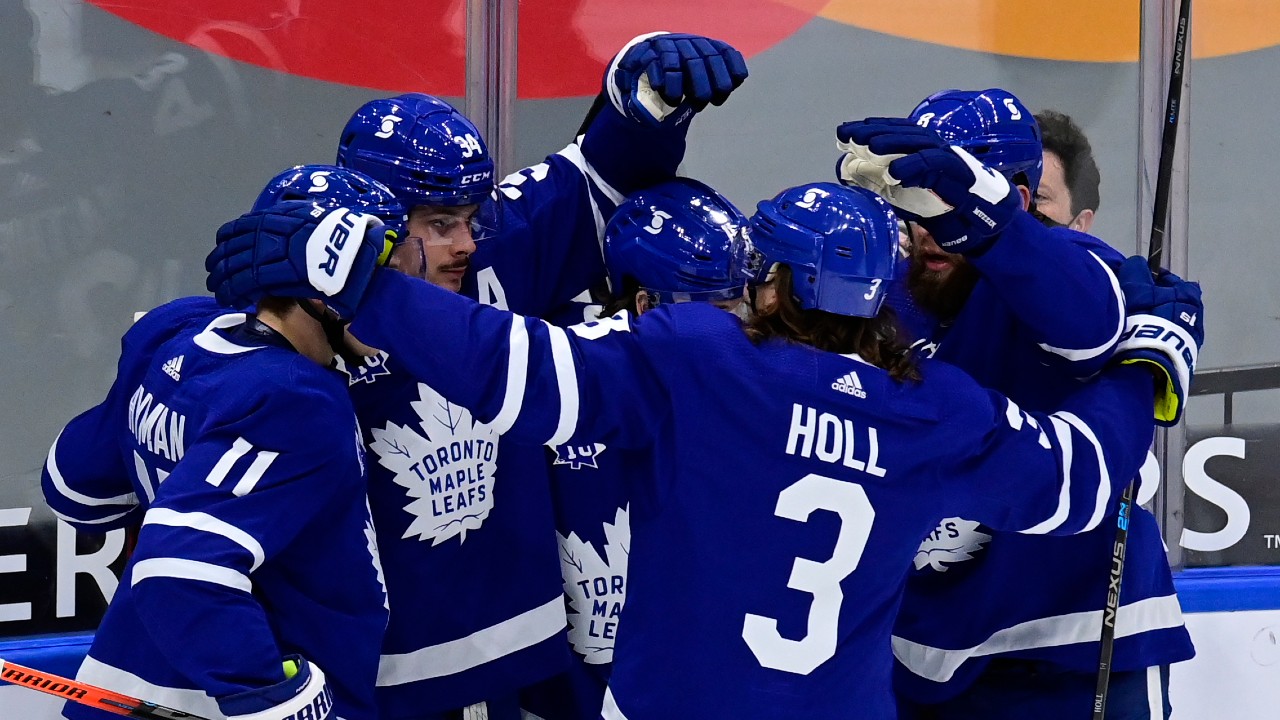

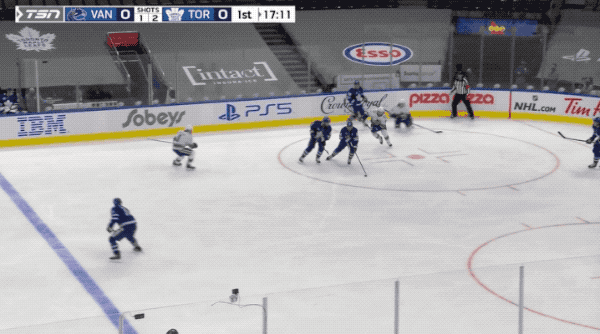
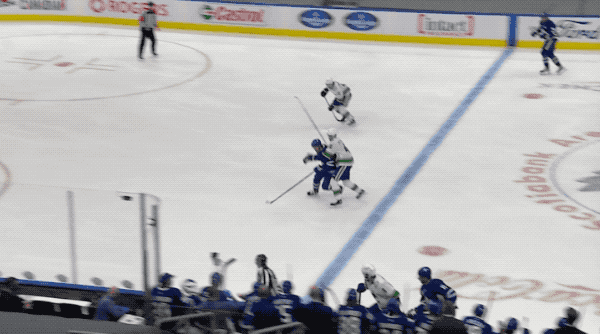
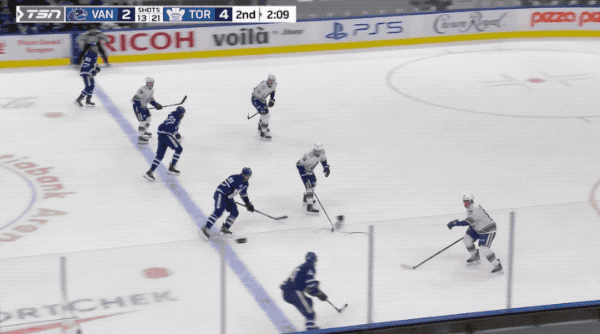
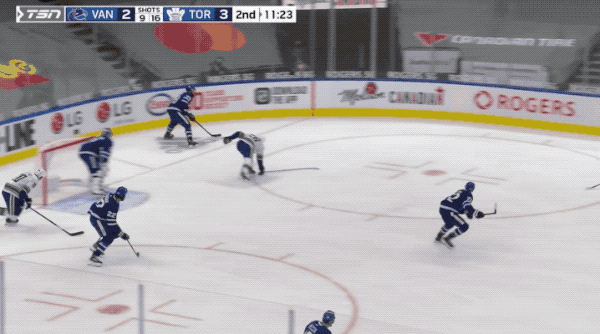
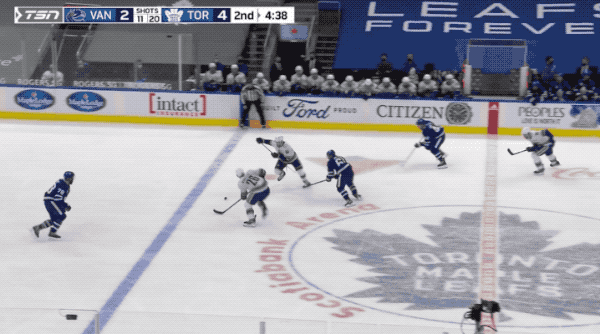
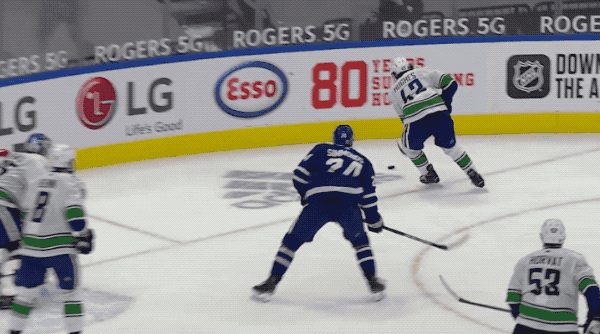
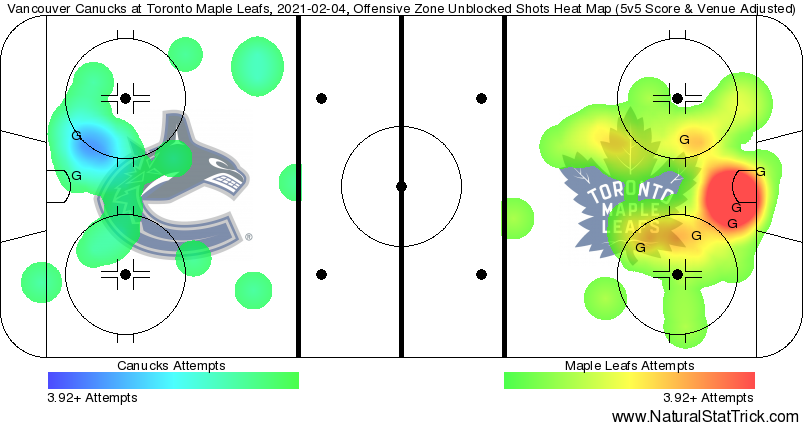
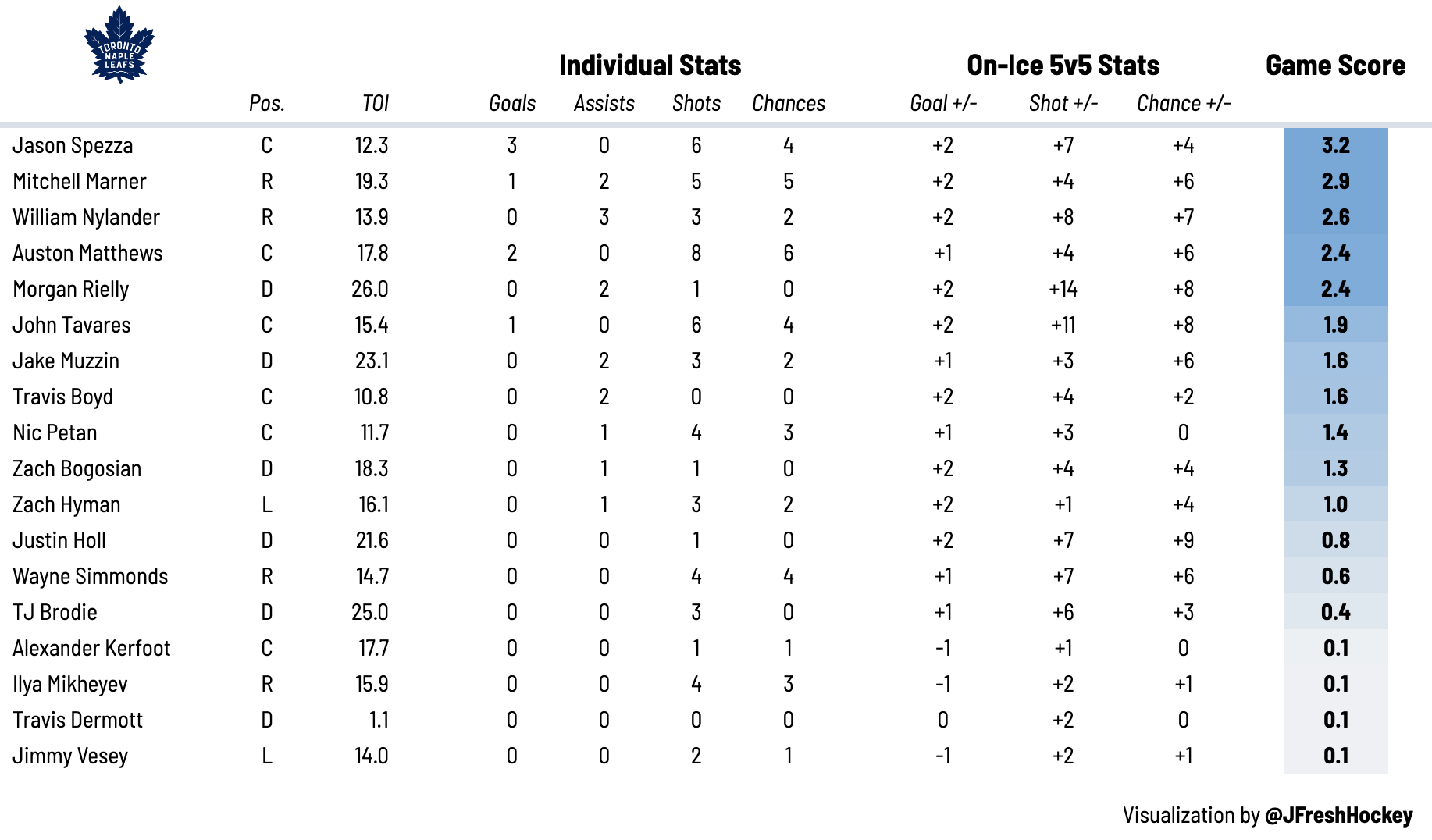

![Sheldon Keefe on the Maple Leafs’ struggling power play: “[We’ve scored] one out of 11 high-danger chances in tight to the net… We have been in those spots and haven’t converted” Sheldon Keefe, playoff press conference](https://mapleleafshotstove.com/wp-content/uploads/2024/04/keefe-pc-game-3-324x235.jpg)



![Jim Montgomery Post Game, Bruins 4 vs. Leafs 2: “[Marchand] still manages to get under people’s skin, yet he doesn’t cross the line” Jim Montgomery, Boston Bruins post game](https://mapleleafshotstove.com/wp-content/uploads/2024/04/jim-monty-pg-to-100x70.jpg)




